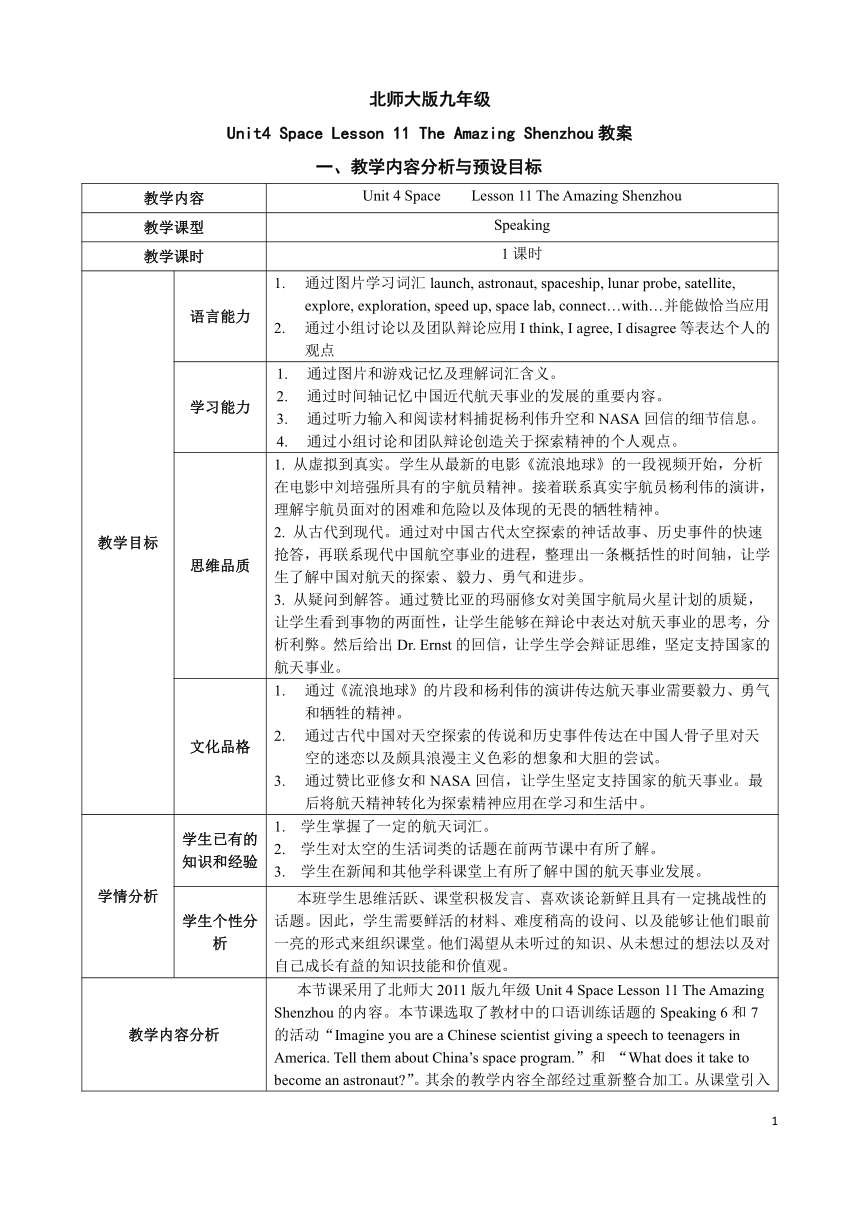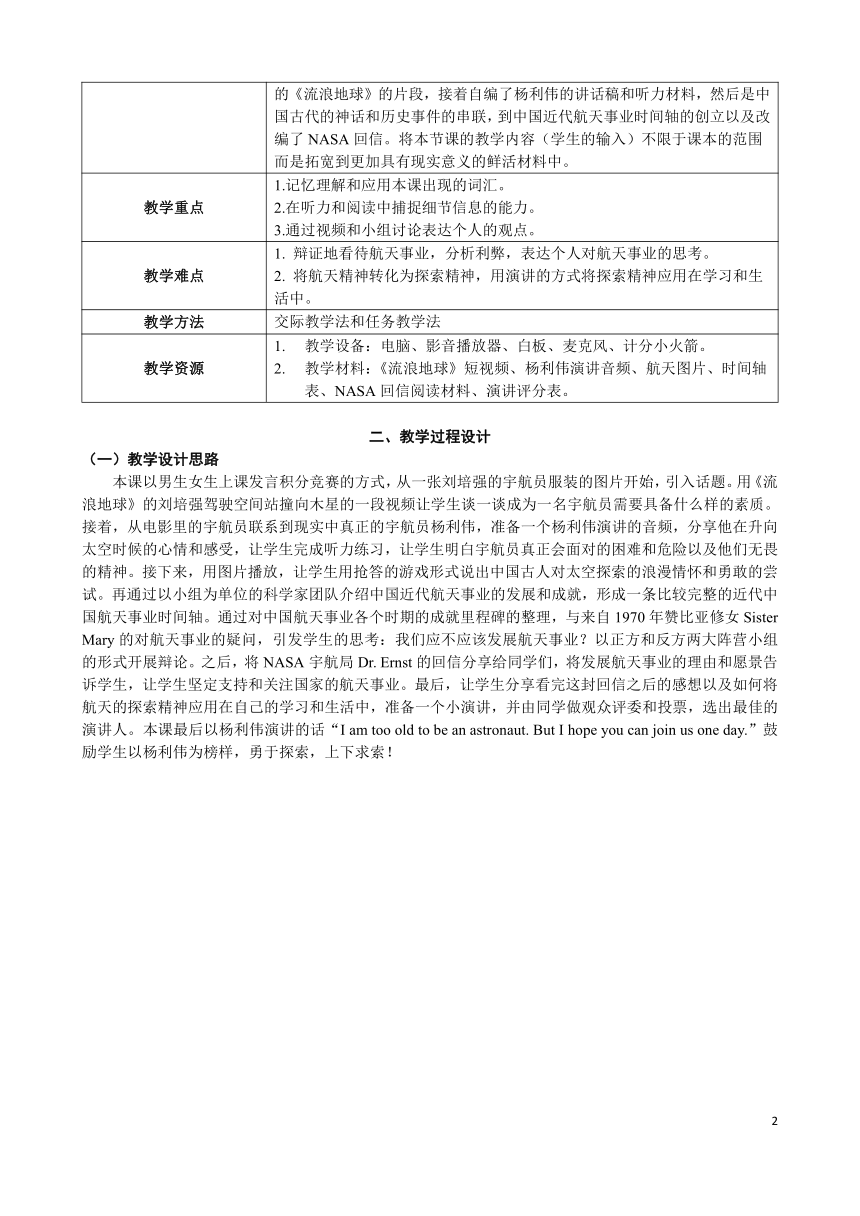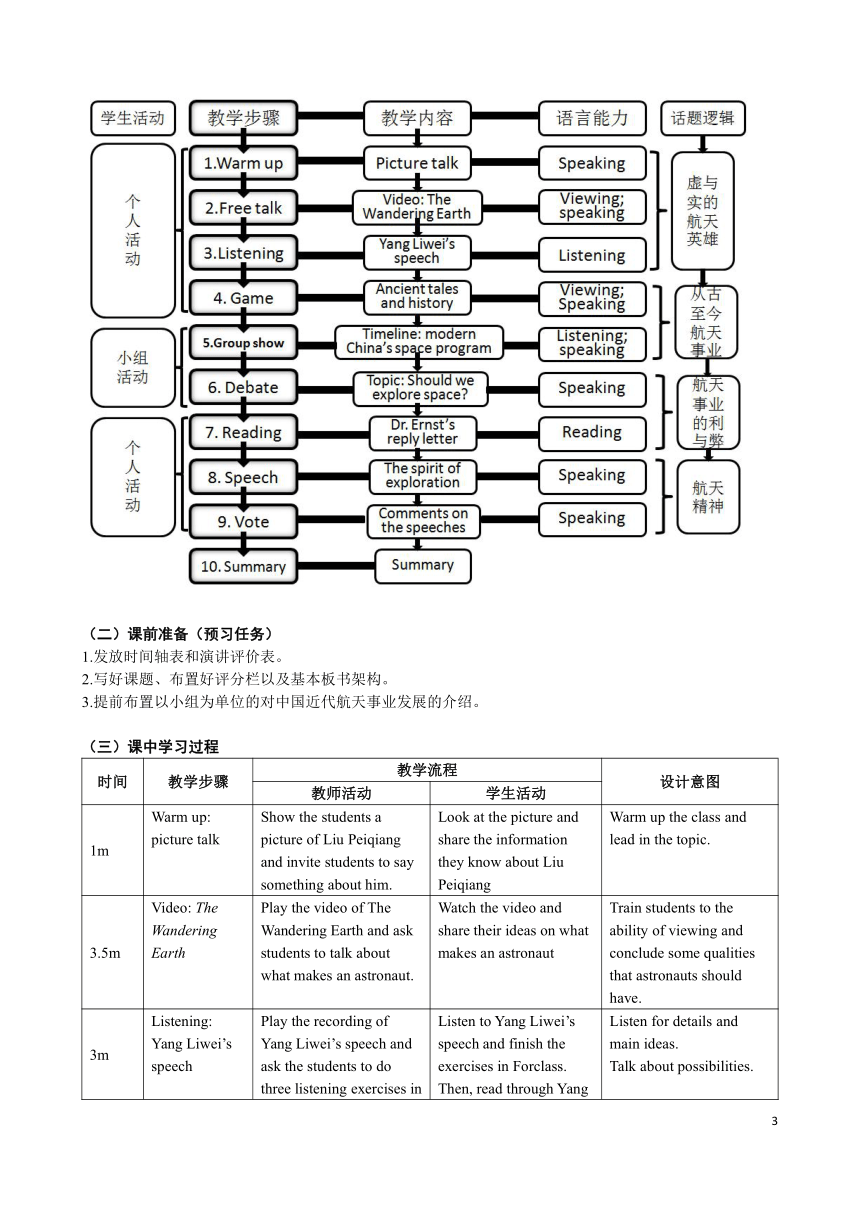Unit 4 Space Lesson 11 The Amazing Shenzhou 教案(表格式)
文档属性
| 名称 | Unit 4 Space Lesson 11 The Amazing Shenzhou 教案(表格式) |  | |
| 格式 | docx | ||
| 文件大小 | 488.3KB | ||
| 资源类型 | 教案 | ||
| 版本资源 | 北师大版 | ||
| 科目 | 英语 | ||
| 更新时间 | 2021-09-29 17:13:52 | ||
图片预览



文档简介
北师大版九年级
Unit4
Space
Lesson
11
The
Amazing
Shenzhou教案
一、教学内容分析与预设目标
教学内容
Unit
4
Space
Lesson
11
The
Amazing
Shenzhou
教学课型
Speaking
教学课时
1课时
教学目标
语言能力
通过图片学习词汇launch,
astronaut,
spaceship,
lunar
probe,
satellite,
explore,
exploration,
speed
up,
space
lab,
connect…with…并能做恰当应用
通过小组讨论以及团队辩论应用I
think,
I
agree,
I
disagree等表达个人的观点
学习能力
通过图片和游戏记忆及理解词汇含义。
通过时间轴记忆中国近代航天事业的发展的重要内容。
通过听力输入和阅读材料捕捉杨利伟升空和NASA回信的细节信息。
通过小组讨论和团队辩论创造关于探索精神的个人观点。
思维品质
1.
从虚拟到真实。学生从最新的电影《流浪地球》的一段视频开始,分析在电影中刘培强所具有的宇航员精神。接着联系真实宇航员杨利伟的演讲,理解宇航员面对的困难和危险以及体现的无畏的牺牲精神。
2.
从古代到现代。通过对中国古代太空探索的神话故事、历史事件的快速抢答,再联系现代中国航空事业的进程,整理出一条概括性的时间轴,让学生了解中国对航天的探索、毅力、勇气和进步。
3.
从疑问到解答。通过赞比亚的玛丽修女对美国宇航局火星计划的质疑,让学生看到事物的两面性,让学生能够在辩论中表达对航天事业的思考,分析利弊。然后给出Dr.
Ernst的回信,让学生学会辩证思维,坚定支持国家的航天事业。
文化品格
通过《流浪地球》的片段和杨利伟的演讲传达航天事业需要毅力、勇气和牺牲的精神。
通过古代中国对天空探索的传说和历史事件传达在中国人骨子里对天空的迷恋以及颇具浪漫主义色彩的想象和大胆的尝试。
通过赞比亚修女和NASA回信,让学生坚定支持国家的航天事业。最后将航天精神转化为探索精神应用在学习和生活中。
学情分析
学生已有的知识和经验
1.
学生掌握了一定的航天词汇。
2.
学生对太空的生活词类的话题在前两节课中有所了解。
3.
学生在新闻和其他学科课堂上有所了解中国的航天事业发展。
学生个性分析
本班学生思维活跃、课堂积极发言、喜欢谈论新鲜且具有一定挑战性的话题。因此,学生需要鲜活的材料、难度稍高的设问、以及能够让他们眼前一亮的形式来组织课堂。他们渴望从未听过的知识、从未想过的想法以及对自己成长有益的知识技能和价值观。
教学内容分析
本节课采用了北师大2011版九年级Unit
4
Space
Lesson
11
The
Amazing
Shenzhou的内容。本节课选取了教材中的口语训练话题的Speaking
6和7的活动“Imagine
you
are
a
Chinese
scientist
giving
a
speech
to
teenagers
in
America.
Tell
them
about
China’s
space
program.”和
“What
does
it
take
to
become
an
astronaut ”。其余的教学内容全部经过重新整合加工。从课堂引入的《流浪地球》的片段,接着自编了杨利伟的讲话稿和听力材料,然后是中国古代的神话和历史事件的串联,到中国近代航天事业时间轴的创立以及改编了NASA回信。将本节课的教学内容(学生的输入)不限于课本的范围而是拓宽到更加具有现实意义的鲜活材料中。
教学重点
1.记忆理解和应用本课出现的词汇。
2.在听力和阅读中捕捉细节信息的能力。
3.通过视频和小组讨论表达个人的观点。
教学难点
1.
辩证地看待航天事业,分析利弊,表达个人对航天事业的思考。
2.
将航天精神转化为探索精神,用演讲的方式将探索精神应用在学习和生活中。
教学方法
交际教学法和任务教学法
教学资源
教学设备:电脑、影音播放器、白板、麦克风、计分小火箭。
教学材料:《流浪地球》短视频、杨利伟演讲音频、航天图片、时间轴表、NASA回信阅读材料、演讲评分表。
二、教学过程设计
(一)教学设计思路
本课以男生女生上课发言积分竞赛的方式,从一张刘培强的宇航员服装的图片开始,引入话题。用《流浪地球》的刘培强驾驶空间站撞向木星的一段视频让学生谈一谈成为一名宇航员需要具备什么样的素质。接着,从电影里的宇航员联系到现实中真正的宇航员杨利伟,准备一个杨利伟演讲的音频,分享他在升向太空时候的心情和感受,让学生完成听力练习,让学生明白宇航员真正会面对的困难和危险以及他们无畏的精神。接下来,用图片播放,让学生用抢答的游戏形式说出中国古人对太空探索的浪漫情怀和勇敢的尝试。再通过以小组为单位的科学家团队介绍中国近代航天事业的发展和成就,形成一条比较完整的近代中国航天事业时间轴。通过对中国航天事业各个时期的成就里程碑的整理,与来自1970年赞比亚修女Sister
Mary的对航天事业的疑问,引发学生的思考:我们应不应该发展航天事业?以正方和反方两大阵营小组的形式开展辩论。之后,将NASA宇航局Dr.
Ernst的回信分享给同学们,将发展航天事业的理由和愿景告诉学生,让学生坚定支持和关注国家的航天事业。最后,让学生分享看完这封回信之后的感想以及如何将航天的探索精神应用在自己的学习和生活中,准备一个小演讲,并由同学做观众评委和投票,选出最佳的演讲人。本课最后以杨利伟演讲的话“I
am
too
old
to
be
an
astronaut.
But
I
hope
you
can
join
us
one
day.”鼓励学生以杨利伟为榜样,勇于探索,上下求索!
课前准备(预习任务)
1.发放时间轴表和演讲评价表。
2.写好课题、布置好评分栏以及基本板书架构。
3.提前布置以小组为单位的对中国近代航天事业发展的介绍。
(三)课中学习过程
时间
教学步骤
教学流程
设计意图
教师活动
学生活动
1m
Warm
up:
picture
talk
Show
the
students
a
picture
of
Liu
Peiqiang
and
invite
students
to
say
something
about
him.
Look
at
the
picture
and
share
the
information
they
know
about
Liu
Peiqiang
Warm
up
the
class
and
lead
in
the
topic.
3.5m
Video:
The
Wandering
Earth
Play
the
video
of
The
Wandering
Earth
and
ask
students
to
talk
about
what
makes
an
astronaut.
Watch
the
video
and
share
their
ideas
on
what
makes
an
astronaut
Train
students
to
the
ability
of
viewing
and
conclude
some
qualities
that
astronauts
should
have.
3m
Listening:
Yang
Liwei’s
speech
Play
the
recording
of
Yang
Liwei’s
speech
and
ask
the
students
to
do
three
listening
exercises
in
the
pad
through
Forclass.
Then,
share
the
Yang
Liwei’s
speech
with
the
students
and
ask
them
to
find
out
the
reasons
that
made
Yang
Liwei
nervous
in
space
and
infer
about
those
reasons
why
they
made
him
nervous.
Listen
to
Yang
Liwei’s
speech
and
finish
the
exercises
in
Forclass.
Then,
read
through
Yang
Liwei’s
speech
and
find
out
the
reasons
that
made
him
nervous
and
infer
why
it
is
so.
Listen
for
details
and
main
ideas.
Talk
about
possibilities.
1.5m
Game
time:
ancient
tales
and
history
Show
students
pictures
of
the
tales
and
history
of
ancient
Chinese’
search
for
the
universe.
Explain
the
rules
and
use
“quick
answer”
button
in
Forclass
to
play
the
game.
Look
at
the
pictures
and
press
the
“quick
answer”
button
in
the
pad
as
quickly
as
possible.
The
first
two
to
press
the
button
will
have
the
chance
to
tell
the
name
of
the
picture.
View
the
pictures
and
associate
the
pictures
with
the
correct
English
names
for
it.
Students
will
be
able
to
see
a
general
picture
of
ancient
Chinese’
search
for
the
universe.
7m
Group
work:
timeline
of
modern
China’s
space
program
Give
students
some
key
words
beforehand
and
invite
four
groups
of
students
to
come
to
the
front
as
scientist
to
introduce
the
milestones
in
modern
China’s
space
industry.
In
other
the
rest
of
the
students
to
listen
and
take
down
notes
in
their
handouts
to
finish
the
timeline.
Four
groups
of
students
stand
in
front
of
the
class
and
introduce
the
achievements
of
modern
China’s
space
program
in
chronological
order.
The
rest
of
the
students
will
listen
carefully
and
take
down
the
missing
information
in
the
timeline
in
their
handouts
Speak
with
key
words
to
give
an
introduction.
Listen
for
details.
With
the
help
of
the
timeline,
students
will
be
able
to
have
a
clear
picture
of
the
modern
China’s
space
program.
13m
Debate:
should
we
explore
space
First,
pose
Sister
Mary’s
question
to
the
students
and
inquire
students’
opinions
on
it.
Then,
ask
the
students
to
discuss
it
and
choose
their
sides.
Give
students
three
minutes
to
discuss.
Next,
rearrange
the
students
to
sit
on
the
right
and
the
left
for
pros
and
cons.
Tell
the
rules
and
give
students
time
to
debate
over
the
topic.
First,
discuss
in
groups
and
choose
their
sides.
Second,
the
pros
sit
on
the
right
and
the
cons
sit
on
the
left.
Third,
start
the
debate
from
the
pros
and
then
cons.
Take
turns
to
state
their
opinions.
Provoke
students
to
think
over
the
pros
and
cons
of
space
exploration.
Students
will
be
able
to
think
critically
over
the
topic
and
use
“I
agree/disagree…”
to
present
their
opinions.
4m
Reading:
Dr.
Ernst’s
reply
letter
Hand
out
Dr.
Ernst’s
reply
letter
to
Sister
Mary
to
the
students
and
ask
them
to
scan
for
the
reasons
that
he
gives
to
explain
the
importance
of
space
exploration.
Read
Dr.
Ernst’s
reply
letter
and
scan
for
the
reasons
he
gives
to
explain
the
importance
of
exploration.
Show
students
the
reasons
for
space
exploration
and
students
will
understand
the
importance
of
exploring
the
universe.
7m
Making
a
speech:
my
idea
on
the
spirit
of
exploration
Ask
the
students
to
think
about
the
questions:
“What
do
you
think
of
space
exploration
after
reading
the
letter
How
do
you
fit
the
spirit
of
exploration
into
our
life ”
Ask
the
students
to
share
their
ideas
in
a
group
and
write
down
some
key
words
as
notes
in
the
handouts.
Then,
invite
volunteers
to
make
speeches.
Share
ideas
on
how
they
think
of
space
exploration
after
reading
the
letter
and
how
they
will
fit
the
spirit
of
exploration
into
their
life
and
study.
Then,
come
to
the
front
and
make
speeches.
Provoke
the
students
to
think
about
how
to
apply
the
spirit
of
exploration
into
their
own
study
and
life.
Students
will
be
able
to
talk
about
their
opinions
and
make
a
speech.
2m
Voting
and
comments.
Ask
students
to
grade
the
speakers
according
to
the
grading
table
under
“language,
content
and
body
language”.
Then
give
comments
to
their
favorite
speaker.
Then,
give
an
overall
comment
on
all
speakers.
Grade
the
speakers
according
to
“language,
content
and
body
language”.
Then
give
comments
to
their
favorite
speaker
and
tell
why
they
like
him
or
her
most.
Then
vote
for
their
favorites
in
forclass.
Grading
the
speakers
helps
students
to
better
appreciate
others’
speeches.
Students
will
be
able
to
speak
and
explain
their
reason
for
their
vote.
1m
Summary
Refer
to
Yang
Liwei’s
speech
again.
Use
Yang
Liwei’s
statement
and
wish
to
encourage
students
to
work
hard
and
apply
the
spirit
of
exploration
in
their
study
and
life.
Learn
to
apply
the
spirit
of
exploration
to
their
study
and
life.
Encourage
students
to
work
hard
and
apply
the
spirit
of
exploration
in
their
study
and
life.
(四)课后学习(课后作业)
Writing
task:
Man
has
been
exploring
the
universe
for
a
long
time.
Some
people
doubt
it
as
Sister
Mary
Jucunda
questioned
NASA
why
they
could
suggest
spending
billions
of
dollars
on
the
project
to
Mars
when
so
many
children
were
starving
on
Earth.
Dr.
Ernst
Stuhlinger’s
reply
letter
reshapes
our
understanding
of
the
importance
of
space
exploration.
Besides,
Prime
Minister
Wen
Jiabao
encourages
university
students
to
be
curious
about
the
mysterious
space.
So
what
do
you
think
of
space
exploration
after
reading
the
letter
How
do
you
fit
the
spirit
of
exploration
into
our
life
(五)教学评价
评价方式
教学环节描述
评价操作方式
1.客观题评价
听力理解的训练题;时间轴的天空题。
学生听听力音频,然后在Forclass系统里面选择答案;学生在纸质的时间轴表格上填入关键词。
2.主观题评价
学生的辩论环节以及即席演讲环节。
学生讨论和分享,探讨太空探索的利与弊,然后辩论;学生稍作准备即席演讲。
3,写作评价
课后作业
写一篇文章分享自己看完美国宇航局回信的感受以及自己如何将探索精神应用在学习和生活。
板书设计
三、教学反思
(一)本节课最大亮点
1.主题鲜明,教学环节主线清晰,逻辑递进。
2.听力和阅读材料丰富。原创性强。
3.学生的口语训练形式多样、口语表达充分锻炼。
4.对学生的思维引导和启发做得比较好,学生能从低阶思维发展到高阶思维。
(二)有待改进或新的尝试
课堂容量大难免会造成对部分内容分析或讨论不够深入。
1
Unit4
Space
Lesson
11
The
Amazing
Shenzhou教案
一、教学内容分析与预设目标
教学内容
Unit
4
Space
Lesson
11
The
Amazing
Shenzhou
教学课型
Speaking
教学课时
1课时
教学目标
语言能力
通过图片学习词汇launch,
astronaut,
spaceship,
lunar
probe,
satellite,
explore,
exploration,
speed
up,
space
lab,
connect…with…并能做恰当应用
通过小组讨论以及团队辩论应用I
think,
I
agree,
I
disagree等表达个人的观点
学习能力
通过图片和游戏记忆及理解词汇含义。
通过时间轴记忆中国近代航天事业的发展的重要内容。
通过听力输入和阅读材料捕捉杨利伟升空和NASA回信的细节信息。
通过小组讨论和团队辩论创造关于探索精神的个人观点。
思维品质
1.
从虚拟到真实。学生从最新的电影《流浪地球》的一段视频开始,分析在电影中刘培强所具有的宇航员精神。接着联系真实宇航员杨利伟的演讲,理解宇航员面对的困难和危险以及体现的无畏的牺牲精神。
2.
从古代到现代。通过对中国古代太空探索的神话故事、历史事件的快速抢答,再联系现代中国航空事业的进程,整理出一条概括性的时间轴,让学生了解中国对航天的探索、毅力、勇气和进步。
3.
从疑问到解答。通过赞比亚的玛丽修女对美国宇航局火星计划的质疑,让学生看到事物的两面性,让学生能够在辩论中表达对航天事业的思考,分析利弊。然后给出Dr.
Ernst的回信,让学生学会辩证思维,坚定支持国家的航天事业。
文化品格
通过《流浪地球》的片段和杨利伟的演讲传达航天事业需要毅力、勇气和牺牲的精神。
通过古代中国对天空探索的传说和历史事件传达在中国人骨子里对天空的迷恋以及颇具浪漫主义色彩的想象和大胆的尝试。
通过赞比亚修女和NASA回信,让学生坚定支持国家的航天事业。最后将航天精神转化为探索精神应用在学习和生活中。
学情分析
学生已有的知识和经验
1.
学生掌握了一定的航天词汇。
2.
学生对太空的生活词类的话题在前两节课中有所了解。
3.
学生在新闻和其他学科课堂上有所了解中国的航天事业发展。
学生个性分析
本班学生思维活跃、课堂积极发言、喜欢谈论新鲜且具有一定挑战性的话题。因此,学生需要鲜活的材料、难度稍高的设问、以及能够让他们眼前一亮的形式来组织课堂。他们渴望从未听过的知识、从未想过的想法以及对自己成长有益的知识技能和价值观。
教学内容分析
本节课采用了北师大2011版九年级Unit
4
Space
Lesson
11
The
Amazing
Shenzhou的内容。本节课选取了教材中的口语训练话题的Speaking
6和7的活动“Imagine
you
are
a
Chinese
scientist
giving
a
speech
to
teenagers
in
America.
Tell
them
about
China’s
space
program.”和
“What
does
it
take
to
become
an
astronaut ”。其余的教学内容全部经过重新整合加工。从课堂引入的《流浪地球》的片段,接着自编了杨利伟的讲话稿和听力材料,然后是中国古代的神话和历史事件的串联,到中国近代航天事业时间轴的创立以及改编了NASA回信。将本节课的教学内容(学生的输入)不限于课本的范围而是拓宽到更加具有现实意义的鲜活材料中。
教学重点
1.记忆理解和应用本课出现的词汇。
2.在听力和阅读中捕捉细节信息的能力。
3.通过视频和小组讨论表达个人的观点。
教学难点
1.
辩证地看待航天事业,分析利弊,表达个人对航天事业的思考。
2.
将航天精神转化为探索精神,用演讲的方式将探索精神应用在学习和生活中。
教学方法
交际教学法和任务教学法
教学资源
教学设备:电脑、影音播放器、白板、麦克风、计分小火箭。
教学材料:《流浪地球》短视频、杨利伟演讲音频、航天图片、时间轴表、NASA回信阅读材料、演讲评分表。
二、教学过程设计
(一)教学设计思路
本课以男生女生上课发言积分竞赛的方式,从一张刘培强的宇航员服装的图片开始,引入话题。用《流浪地球》的刘培强驾驶空间站撞向木星的一段视频让学生谈一谈成为一名宇航员需要具备什么样的素质。接着,从电影里的宇航员联系到现实中真正的宇航员杨利伟,准备一个杨利伟演讲的音频,分享他在升向太空时候的心情和感受,让学生完成听力练习,让学生明白宇航员真正会面对的困难和危险以及他们无畏的精神。接下来,用图片播放,让学生用抢答的游戏形式说出中国古人对太空探索的浪漫情怀和勇敢的尝试。再通过以小组为单位的科学家团队介绍中国近代航天事业的发展和成就,形成一条比较完整的近代中国航天事业时间轴。通过对中国航天事业各个时期的成就里程碑的整理,与来自1970年赞比亚修女Sister
Mary的对航天事业的疑问,引发学生的思考:我们应不应该发展航天事业?以正方和反方两大阵营小组的形式开展辩论。之后,将NASA宇航局Dr.
Ernst的回信分享给同学们,将发展航天事业的理由和愿景告诉学生,让学生坚定支持和关注国家的航天事业。最后,让学生分享看完这封回信之后的感想以及如何将航天的探索精神应用在自己的学习和生活中,准备一个小演讲,并由同学做观众评委和投票,选出最佳的演讲人。本课最后以杨利伟演讲的话“I
am
too
old
to
be
an
astronaut.
But
I
hope
you
can
join
us
one
day.”鼓励学生以杨利伟为榜样,勇于探索,上下求索!
课前准备(预习任务)
1.发放时间轴表和演讲评价表。
2.写好课题、布置好评分栏以及基本板书架构。
3.提前布置以小组为单位的对中国近代航天事业发展的介绍。
(三)课中学习过程
时间
教学步骤
教学流程
设计意图
教师活动
学生活动
1m
Warm
up:
picture
talk
Show
the
students
a
picture
of
Liu
Peiqiang
and
invite
students
to
say
something
about
him.
Look
at
the
picture
and
share
the
information
they
know
about
Liu
Peiqiang
Warm
up
the
class
and
lead
in
the
topic.
3.5m
Video:
The
Wandering
Earth
Play
the
video
of
The
Wandering
Earth
and
ask
students
to
talk
about
what
makes
an
astronaut.
Watch
the
video
and
share
their
ideas
on
what
makes
an
astronaut
Train
students
to
the
ability
of
viewing
and
conclude
some
qualities
that
astronauts
should
have.
3m
Listening:
Yang
Liwei’s
speech
Play
the
recording
of
Yang
Liwei’s
speech
and
ask
the
students
to
do
three
listening
exercises
in
the
pad
through
Forclass.
Then,
share
the
Yang
Liwei’s
speech
with
the
students
and
ask
them
to
find
out
the
reasons
that
made
Yang
Liwei
nervous
in
space
and
infer
about
those
reasons
why
they
made
him
nervous.
Listen
to
Yang
Liwei’s
speech
and
finish
the
exercises
in
Forclass.
Then,
read
through
Yang
Liwei’s
speech
and
find
out
the
reasons
that
made
him
nervous
and
infer
why
it
is
so.
Listen
for
details
and
main
ideas.
Talk
about
possibilities.
1.5m
Game
time:
ancient
tales
and
history
Show
students
pictures
of
the
tales
and
history
of
ancient
Chinese’
search
for
the
universe.
Explain
the
rules
and
use
“quick
answer”
button
in
Forclass
to
play
the
game.
Look
at
the
pictures
and
press
the
“quick
answer”
button
in
the
pad
as
quickly
as
possible.
The
first
two
to
press
the
button
will
have
the
chance
to
tell
the
name
of
the
picture.
View
the
pictures
and
associate
the
pictures
with
the
correct
English
names
for
it.
Students
will
be
able
to
see
a
general
picture
of
ancient
Chinese’
search
for
the
universe.
7m
Group
work:
timeline
of
modern
China’s
space
program
Give
students
some
key
words
beforehand
and
invite
four
groups
of
students
to
come
to
the
front
as
scientist
to
introduce
the
milestones
in
modern
China’s
space
industry.
In
other
the
rest
of
the
students
to
listen
and
take
down
notes
in
their
handouts
to
finish
the
timeline.
Four
groups
of
students
stand
in
front
of
the
class
and
introduce
the
achievements
of
modern
China’s
space
program
in
chronological
order.
The
rest
of
the
students
will
listen
carefully
and
take
down
the
missing
information
in
the
timeline
in
their
handouts
Speak
with
key
words
to
give
an
introduction.
Listen
for
details.
With
the
help
of
the
timeline,
students
will
be
able
to
have
a
clear
picture
of
the
modern
China’s
space
program.
13m
Debate:
should
we
explore
space
First,
pose
Sister
Mary’s
question
to
the
students
and
inquire
students’
opinions
on
it.
Then,
ask
the
students
to
discuss
it
and
choose
their
sides.
Give
students
three
minutes
to
discuss.
Next,
rearrange
the
students
to
sit
on
the
right
and
the
left
for
pros
and
cons.
Tell
the
rules
and
give
students
time
to
debate
over
the
topic.
First,
discuss
in
groups
and
choose
their
sides.
Second,
the
pros
sit
on
the
right
and
the
cons
sit
on
the
left.
Third,
start
the
debate
from
the
pros
and
then
cons.
Take
turns
to
state
their
opinions.
Provoke
students
to
think
over
the
pros
and
cons
of
space
exploration.
Students
will
be
able
to
think
critically
over
the
topic
and
use
“I
agree/disagree…”
to
present
their
opinions.
4m
Reading:
Dr.
Ernst’s
reply
letter
Hand
out
Dr.
Ernst’s
reply
letter
to
Sister
Mary
to
the
students
and
ask
them
to
scan
for
the
reasons
that
he
gives
to
explain
the
importance
of
space
exploration.
Read
Dr.
Ernst’s
reply
letter
and
scan
for
the
reasons
he
gives
to
explain
the
importance
of
exploration.
Show
students
the
reasons
for
space
exploration
and
students
will
understand
the
importance
of
exploring
the
universe.
7m
Making
a
speech:
my
idea
on
the
spirit
of
exploration
Ask
the
students
to
think
about
the
questions:
“What
do
you
think
of
space
exploration
after
reading
the
letter
How
do
you
fit
the
spirit
of
exploration
into
our
life ”
Ask
the
students
to
share
their
ideas
in
a
group
and
write
down
some
key
words
as
notes
in
the
handouts.
Then,
invite
volunteers
to
make
speeches.
Share
ideas
on
how
they
think
of
space
exploration
after
reading
the
letter
and
how
they
will
fit
the
spirit
of
exploration
into
their
life
and
study.
Then,
come
to
the
front
and
make
speeches.
Provoke
the
students
to
think
about
how
to
apply
the
spirit
of
exploration
into
their
own
study
and
life.
Students
will
be
able
to
talk
about
their
opinions
and
make
a
speech.
2m
Voting
and
comments.
Ask
students
to
grade
the
speakers
according
to
the
grading
table
under
“language,
content
and
body
language”.
Then
give
comments
to
their
favorite
speaker.
Then,
give
an
overall
comment
on
all
speakers.
Grade
the
speakers
according
to
“language,
content
and
body
language”.
Then
give
comments
to
their
favorite
speaker
and
tell
why
they
like
him
or
her
most.
Then
vote
for
their
favorites
in
forclass.
Grading
the
speakers
helps
students
to
better
appreciate
others’
speeches.
Students
will
be
able
to
speak
and
explain
their
reason
for
their
vote.
1m
Summary
Refer
to
Yang
Liwei’s
speech
again.
Use
Yang
Liwei’s
statement
and
wish
to
encourage
students
to
work
hard
and
apply
the
spirit
of
exploration
in
their
study
and
life.
Learn
to
apply
the
spirit
of
exploration
to
their
study
and
life.
Encourage
students
to
work
hard
and
apply
the
spirit
of
exploration
in
their
study
and
life.
(四)课后学习(课后作业)
Writing
task:
Man
has
been
exploring
the
universe
for
a
long
time.
Some
people
doubt
it
as
Sister
Mary
Jucunda
questioned
NASA
why
they
could
suggest
spending
billions
of
dollars
on
the
project
to
Mars
when
so
many
children
were
starving
on
Earth.
Dr.
Ernst
Stuhlinger’s
reply
letter
reshapes
our
understanding
of
the
importance
of
space
exploration.
Besides,
Prime
Minister
Wen
Jiabao
encourages
university
students
to
be
curious
about
the
mysterious
space.
So
what
do
you
think
of
space
exploration
after
reading
the
letter
How
do
you
fit
the
spirit
of
exploration
into
our
life
(五)教学评价
评价方式
教学环节描述
评价操作方式
1.客观题评价
听力理解的训练题;时间轴的天空题。
学生听听力音频,然后在Forclass系统里面选择答案;学生在纸质的时间轴表格上填入关键词。
2.主观题评价
学生的辩论环节以及即席演讲环节。
学生讨论和分享,探讨太空探索的利与弊,然后辩论;学生稍作准备即席演讲。
3,写作评价
课后作业
写一篇文章分享自己看完美国宇航局回信的感受以及自己如何将探索精神应用在学习和生活。
板书设计
三、教学反思
(一)本节课最大亮点
1.主题鲜明,教学环节主线清晰,逻辑递进。
2.听力和阅读材料丰富。原创性强。
3.学生的口语训练形式多样、口语表达充分锻炼。
4.对学生的思维引导和启发做得比较好,学生能从低阶思维发展到高阶思维。
(二)有待改进或新的尝试
课堂容量大难免会造成对部分内容分析或讨论不够深入。
1
同课章节目录
- Unit 1 Language
- Lesson 1 Body Language
- Lesson 2 Different Kinds of Language
- Lesson 3 Language Learning Tips
- Communication Workshop
- Unit 2 Books
- Lesson 4 Classics
- Lesson 5 The Book Club
- Lesson 6 Tom Sawye
- Communication Workshop
- Unit 3 Creativity
- Lesson 7 A Famous Invento
- Lesson 8 Good or Bad?
- Lesson 9 Creative Minds
- Communication Workshop
- Unit 4 Space
- Lesson 10 Life in Space
- Lesson 11 The Amazing Shenzhou
- Lesson 12 The Spaceship
- Communication Workshop
- Unit 5 Literature
- Lesson 13 Anne of Green Gables
- Lesson 14 The Dark Room
- Lesson 15 A Famous Write
- Communication Workshop
- Unit 6 Role Models
- Lesson 16 Yao Ming
- Lesson 17 People in Our Lives
- Lesson 18 Steve Jobs
- Communication Workshop
- Unit 7 Journeys
- Lesson 19 The Silk Road
- Lesson 20 Life in a Journey
- Lesson 21 To the South Pole
- Communication Workshop
- Unit 8 Discoveries
- Lesson 22 Famous Discoveries
- Lesson 23 Discovery of the Yea
- Lesson 24 An Experiment Report
- Communication Workshop
- Unit 9 Save the Planet
- Lesson 25 Going Green
- Lesson 26 Our Rive
- Lesson 27 Tree Heroes
- Communication Workshop
